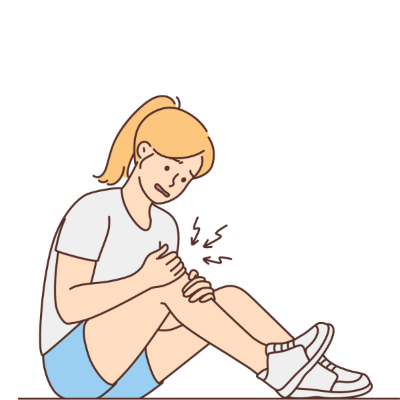ACL Injury Risk for Women
The knee is a complex joint that undergoes a lot of stress through daily and physical activities. Common injuries include patellar tendinopathy, meniscus tears and ligament injuries. One of the more significant injuries to the knee is an anterior cruciate ligament (ACL) sprain/tear. Women are 2-8x more likely to experience an ACL tear than men, with the difference in incidence varying by sport. The ACL is an important ligament that provides stability to the knee by preventing anterior translation of the tibia and resisting tibial rotational forces. Spraining, or tearing, the ACL can have profound impacts on knee stability and, subsequently activity participation.
Anatomy
The knee has four main ligaments that provide stability. The medial collateral ligament (MCL) is on the inside of the knee and runs from the femur to the tibia. It helps prevent the knee from collapsing inward. On the outside, the lateral collateral ligament (LCL) runs from the femur to the fibula. It helps prevent outward forces. The posterior cruciate ligament (PCL) and the anterior cruciate ligament (ACL) are deep in the knee. The PCL sits behind the ACL and helps prevent posterior translation of the tibia on the femur- similar to the quadriceps muscles. The ACL helps prevent anterior translation of the tibia on the femur as well as resist rotation of the tibia. It works in conjunction with the hamstring muscles which also resist anterior translation of the tibia on the femur. These ligaments have both blood and nerve supply, providing proprioceptive information to the brain. Receptors in the ligaments detect stretching and rapid movements, providing the brain with positional information. The ACL is composed of two bundles that cross over each other. The anteromedial bundle is tight when the knee is flexed, and the posterolateral bundle is tight when the knee is straight.

Injury Risk
Women are at an increased risk for an ACL injury. This risk has been found to range from 2-8x more likely than men, depending on the activity. Despite extensive research, we still do not fully understand why this risk is so much higher. A number of theories and factors have been posited. One theory has to do with pelvis anatomy. Women generally have a larger pelvis-to-femur length ratio which can increase stress on the knee joints. Women also have, on average, less muscle mass around the knee than men. Lower muscle mass surrounding a joint decreases the ability to stabilize and protect that joint.
Another contributing factor may be technique education. Traditionally, the activities young boys and young girls are encouraged to participate in differ, which may lead to a difference in muscle control development. Research into gender differences in neuromuscular activation patterns (brain-muscle communication and control) has found females take significantly longer to generate maximum hamstring torque during isokinetic muscle testing than males. Females were found to contract their quadriceps muscles first instead of hamstring muscles in response to anterior tibia translation, which can actually increase anterior tibial translation rather than reduce it (and thus increase injury risk).
Injury Mechanism and Rehabilitation
ACL tears occur both from contact with another player and non-contact mechanisms. In fact, non-contact injuries are more common, with up to 70% of ACL injuries occurring without contact. The ACL is most stressed when the foot is planted, the tibia (shin) is internally rotated and the knee collapses inward. In other words, planting and pivoting places the most stress on the ACL. This is why ACL injuries are common in pivoting sports such as soccer and football. Hyperextension of the knee is another common mechanism for ACL tears.

Rehabilitation
If you’re familiar with ACL injuries you likely know recovery can be a long road. Fortunately, we have both conservative and surgical options. The decision to rehabilitate conservatively or surgically comes down to a number of factors and should involve an extensive discussion with your healthcare team. ACL injuries rarely occur in isolation and often involve MCL and meniscus injuries too. As with most injuries, I encourage conservative, non-surgical management first. If non-surgical rehabilitation can achieve enough knee stability for your goals, surgery can usually be avoided.
With all injuries, prevention is the best treatment. One of the easiest prevention tools we can use for preventing ACL injuries is a proper warm-up before activity, specifically a neuromuscular warm-up. This type of warm-up aims to improve joint proprioception, heighten receptor sensitivity and improve overall brain-muscle communication during the activity. These types of warm-ups will involve balance, stability and agility exercises. The Fifa 11+ is an example of a neuromuscular warm-up that was specifically designed for soccer. The Sports Injury Prevention Research Centre at the University of Calgary is a good resource for neuromuscular warm-ups for various activities. These resources can be found at https://www.ucalgary.ca/shred-injuries/all-sports.
There is a lot of work that goes into rehabilitating an ACL injury, and you don’t have to do it alone. Along with rehabilitation, we can also develop a program for injury prevention. Contact me today for an individualized treatment and rehabilitation program, and get back on the road to recovery!
Crystal Bartkowski, B.A.,B.HPED.,CAT(C)
Certified Athletic Therapist
